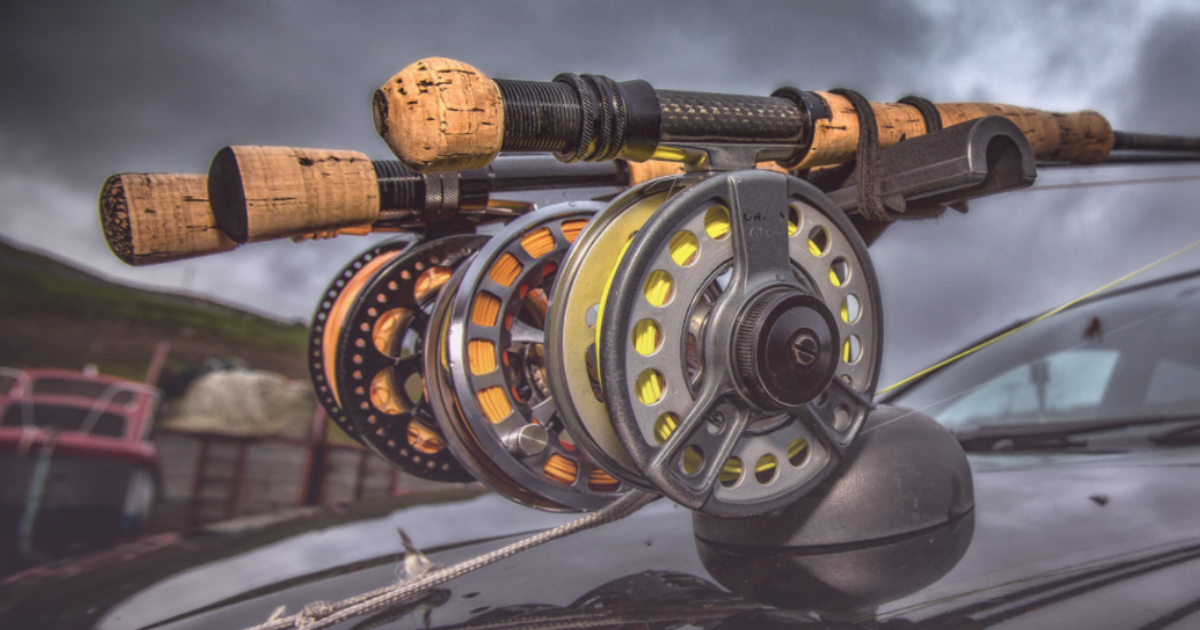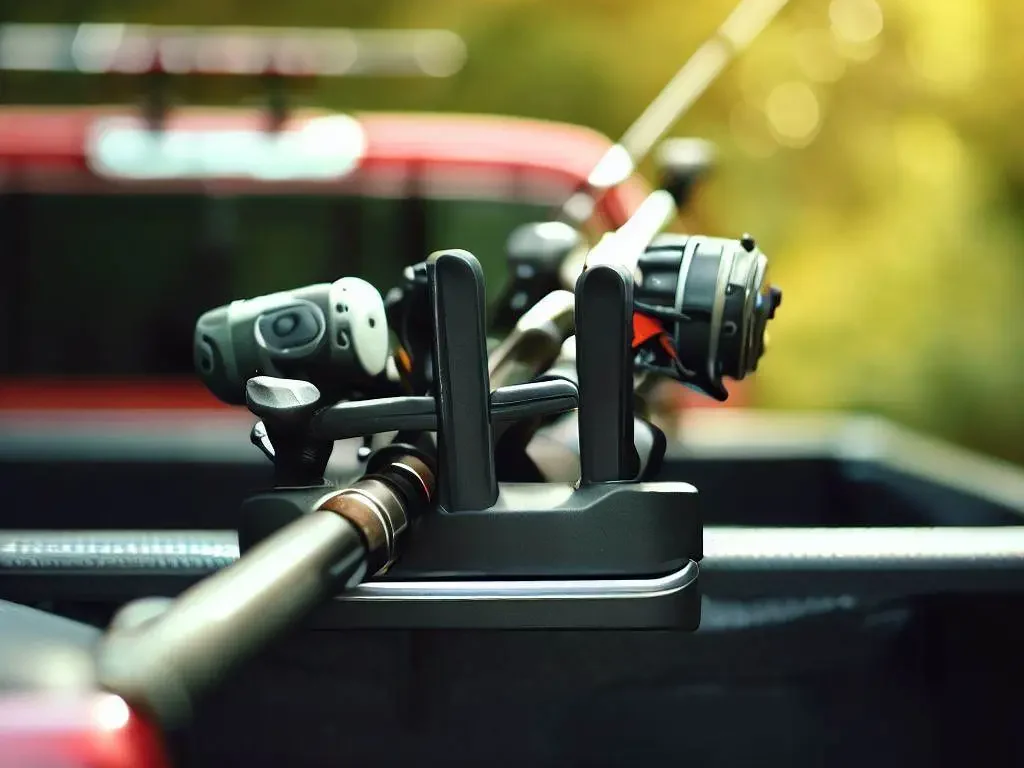When planning a fishing trip, it’s important to know how to transport fishing rods in a truck to avoid damage to your precious gear.
Transporting fishing rods can be a tricky endeavor, especially if you want to ensure they remain in pristine condition. Maybe you’re an angler preparing for a weekend getaway or just someone keen on maximizing space while traveling, it’s imperative to know the best way to transport fishing rods in a truck.
With various methods and techniques available, some methods stand out as more efficient and safer than others.
This guide not only delves deep into how to store fishing rods in trucks but also offers comprehensive insights into the dos and don’ts of how to transport fishing rods.
So, whether you’re a novice or a seasoned fisherman, you’ll find these tips beneficial when it comes to transporting fishing rods in a truck.
Let’s dive in and make sure your rods arrive in top-notch condition at your fishing destination.

Table of Contents
Assessing Your Fishing Rods and Truck Space
Consider the length and quantity of your fishing rods. The type of fishing you plan to do and the rods required will differ – for instance, muskie fishing rods tend to be longer than rods used for kayak fishing.
Here’s a quick summary of different rod types:
| Type | Length |
|---|---|
| Muskie Fishing | 8′-10′ |
| Kayak Fishing | 6′-7′ |
| Bass Fishing | 5′-8′ |
Evaluate the space available in your truck. Factors to keep in mind include:
- Truck bed: The truck bed is the most common place to transport fishing rods. Assess the space to ensure you can safely transport all your rods without causing damage.
- Roof cab space: Trucks with little roof cab space may need a special attachment, like a rod holder or roof rack, for transporting rods.
- Interior space (passenger seat and rear window area): Depending on the rod length, you may be able to transport fishing rods inside your truck, using the driver’s center console or by securing rods along the passenger seat, front windshield, and back window.
Now that you have an understanding of your fishing rods and truck space, you can explore the different methods of transporting fishing rods:
Taking the time to assess your fishing rods and the available space in your truck will help ensure you can transport your gear safely to your favorite fishing spot.
Keep these considerations in mind as you explore the various options for transporting your fishing rods in a truck. Remember, the goal here is to find the safest, most secure method that works for you and your specific needs.
Now that you have an understanding of your fishing rods and truck space, you can explore the different methods of transporting fishing rods.
DIY Solutions for Transporting Fishing Rods in Truck [VIDEO]
There are several simple and effective ways to transport fishing rods in a truck, including:
- Portable rod storage tubes
- Roof-mounted rod tubes
- Rod wraps
- Truck bed rod holders
#1: Portable rod storage tubes
If you are looking for a diy truck bed fishing rod holder this is for you.
Transporting fishing rods in a truck can be a challenge. With a little creativity and some basic materials, though, I’ve found a few DIY solutions that have helped make my fishing trips hassle-free.
Materials Needed:
- PVC tube (with a diameter slightly larger than your widest fishing rod)
- Two PVC end caps
- A locking mechanism (such as a padlock or a lockable latch)
- A measuring tape or ruler
- PVC pipe cutter or a saw
- PVC cement (optional for a more secure seal)
- Sandpaper (optional for smoothening rough edges)
Steps:
1. Measure Your Fishing Rod:
- Lay down your longest fishing rod on a flat surface.
- Using a measuring tape or ruler, measure the total length of the rod. Add a couple of inches to this measurement to ensure that the rod fits comfortably within the tube.
2. Cut the PVC Tube:
- Using the measurement from the previous step, mark the PVC tube.
- With the PVC pipe cutter or a saw, cut the tube at the marked point. Ensure the cut is as straight as possible.
3. Smoothen the Edges (optional):
- After cutting, there might be some rough edges. Use sandpaper to smoothen them out, ensuring there are no sharp or jagged parts.
4. Seal One End of the Tube:
- Take one of the PVC end caps and place it on one end of the tube.
- If you want a more permanent and water-tight seal, apply some PVC cement around the edge of the tube before placing the cap on. Press firmly and let it set according to the cement’s instructions.
5. Add a Locking Mechanism to the Other End:
- On the open end, fit the second PVC cap but don’t seal it permanently.
- Add your locking mechanism. If using a lockable latch, attach it to the cap so that when it’s in place, the latch can be locked, keeping the cap secure.
6. Store and Transport:
- Place your fishing rods inside the newly created storage tube.
- Seal the open end with the lockable cap.
- Position the storage tube in your truck bed, roof rack, or cab, ensuring it’s secure and won’t roll or move during transport.
And there you have it! Your own Portable Rod Storage Tube to protect and transport your fishing rods safely. It’s an economical and efficient solution that not only secures your rods but also shields them from environmental elements.
#2: Roof-mounted rod tubes
Another option is the use of roof-mounted rod tubes. These are durable storage tubes that fit on top of the truck, utilizing the little roof cab space that may be available.
A rod tube helps to safely transport the rods without the risk of damage due to the enclosed space. Some prefer roof rack systems with upright rod holders to hold the rods in place.
#3: Rod wraps
An important aspect of the transportation process is ensuring the rod tips are protected.
Many anglers use rod wraps or rod containers to keep the delicate tips safe during transit. A rod wrap is a simple solution that can be secured around the rod, preventing the line from tangling and other potential damage.
For those who prefer a more budget-friendly option, consider using only a rod wrap. Secure all your rods together by wrapping the fishing line around them, making sure to keep the rod tips protected.
Once wrapped, you can lay the bundle across the front windshield or back window, with one end resting on the passenger seat and the other end near the driver’s center console. This method requires a little roof cab space but is a cost-effective solution for transporting fishing rods.
#4: Truck bed rod holders
If you’re into kayak fishing, DIY rod holders for your truck bed can make transporting your gear more manageable. Repurpose old rod containers, find some PVC tubes or purchase pre-made truck bed rod holders, then attach them to the truck bed using durable bungees or straps. Ensure that these holders are well-secured to avoid any accidents or damage during transportation.
Remember, the key is always to protect and secure your rods properly, regardless of the method you choose, to ensure you arrive at your fishing spot with all your gear intact and ready for that next big catch.
To add an extra level of protection, be sure to lock your rods in the holder, tube, or another secure location on the vehicle. This not only guarantees safe transportation but also prevents theft. The integrity of your reels should not be overlooked either, and many anglers choose to transport them separately or to lock them in a more secure location within the vehicle, such as the driver’s center console.

Using a Fishing Rod Rack for Secure Transport
Figuring out how to transport fishing rods in a truck can be a challenging task. However, one secure and efficient method is to use a rod rack.
Often, the fishing rods won’t fit inside a truck, especially if you have other fishing gear to transport as well. One popular choice among anglers is using a rod holder or a rod rack to keep the rods in place securely. A rod holder allows you to mount the rods on your truck bed or roof rails on both sides of the truck’s back window. This places your fishing gear and rods safely out of harm’s way while you drive.
A rod rack offers several advantages for the transportation of fishing rods:
- Rods rest securely, reducing the risk of damage
- Easier access to all your rods during your fishing trip
- Can accommodate many rods at once, making life easier for those who love to fish with multiple rod types
Properly Securing Your Fishing Gear
When it comes to how to transport fishing rods in a truck, it’s essential to ensure that your fishing gear is properly secured. This makes sure that your fishing rods and other fishing gear stay safe and undamaged during the journey to your fishing spot.
Investing in a good fishing rod holder is highly recommended. These rod holders are specifically designed to hold and protect your rods, making it easier for you to transport fishing rods in your truck bed or boat.
There are various types of rod holders available, such as portable rod storage tubes, roof-mounted rod tubes, and kayak fishing rod holders. Choosing the right one for your needs depends on factors like the number of rods, length of the rods, and space available in your vehicle.
If you have many rods, using a rod wrap is a great way to keep your rods together and save space. Here’s how to create a simple rod wrap:
- Place all your rods side by side with the reels removed and the tips aligned.
- Use a durable Velcro strap or a bungee cord to wrap around the rods, securing them tightly.
- Ensure the rod tips are protected by using tip covers or foam padding.
If you’re lacking little roof cab space, another option to transport fishing rods is placing them inside the truck’s cabin. To do this, you can:
- Place the rod tips under the driver’s center console or the front windshield, ensuring that they don’t obstruct your view.
- Stretch the rods across the passenger seat, extending them toward the rear window or back seat.
- Use durable bungees or straps to secure the rods, making sure they don’t slip and slide during transportation.
For those with truck beds, creating a DIY rod holder using a PVC tube can be a cost-effective and flexible solution. To make one, simply:
- Purchase a PVC tube of the appropriate diameter and length for your fishing rods.
- Cut the tube to create individual rod containers and drill holes for ventilation.
- Secure the PVC tube in your truck bed using straps or bungee cords, ensuring it doesn’t move while driving.
When using a truck with roof rails or a roof rack, you can also consider attaching your rod holders or storage tubes to the rails. This can free up space inside the vehicle and keep your rods safely stowed away during transportation.
Regardless of the method you choose, it’s essential to always double-check that your rods are securely fastened before starting your journey. By following these tips and being diligent with your rod storage and transportation, you’ll be able to focus on the joy of fishing, knowing that your gear is safe and sound.
Read also: How To Transport Fishing Rods In Car & How To Store Fishing Rods In Garage?
Conclusion
our comprehensive guide on how to transport fishing rods, it’s evident that the key to a successful fishing trip often starts well before reaching the water. The best way to transport fishing rods in a truck hinges on several factors, from the type of rods you own to the distance of your journey.
It’s crucial to understand how to store fishing rods in a truck to avoid damage and ensure your gear remains in pristine condition. When transporting fishing rods, the prime objective should always be safety and convenience.
So, the next time you’re planning a trip, remember these valuable insights on how to carry fishing rods in the truck bed and guarantee that your equipment reaches its destination in top-notch shape.
